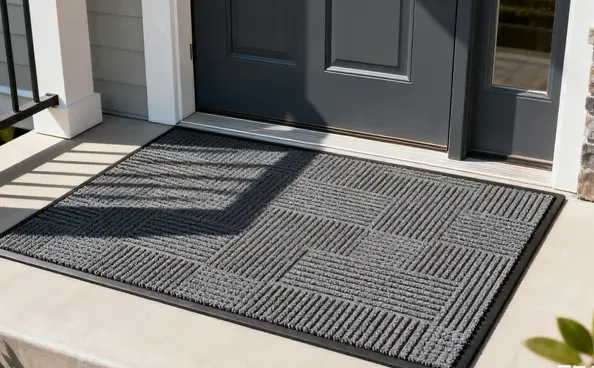As we spend more time perfecting the interiors and exteriors of our homes, doormats have evolved from being simple functional items to stylish pieces that reflect our personality and taste. With the growing focus on home aesthetics and sustainability, the doormat market is seeing some exciting trends that are not just about functionality but also style and environmental consciousness.
The trend in doormats is a combination of durability, eco-friendliness, and personalization, all while keeping the traditional function of keeping dirt out.
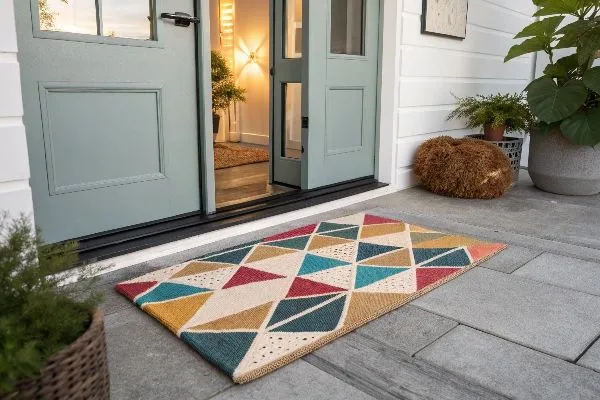
From the best materials to the most popular designs, let’s dive into the trends that are shaping the doormat industry today.
What is the best material for an outside doormat?
Choosing the right material for an outdoor doormat is crucial for its durability, cleanliness, and ability to withstand various weather conditions. Certain materials excel in wet environments, while others perform better in dry or windy conditions.
The best material for an outside doormat depends on factors like weather conditions, maintenance, and style preferences.
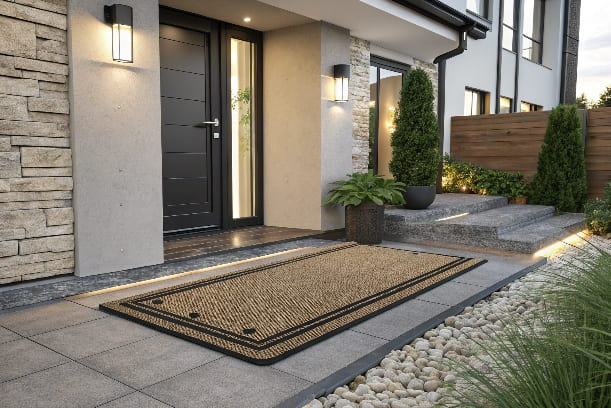
Popular Materials for Outdoor Doormats
-
Coir: Coir mats, made from coconut husks, have been a long-time favorite for outdoor mats due to their durability, ability to trap dirt, and eco-friendly nature. They are naturally water-resistant and great for dry to moderately wet environments. Coir mats also have a rustic, natural look that suits various home styles.
-
Rubber: Rubber doormats are great for wet climates since they don’t absorb water. They’re also slip-resistant and easy to clean, making them a popular choice for homes in rainy or snowy regions. However, rubber mats may not provide the same aesthetic appeal as coir or fabric mats.
-
Polypropylene1: This synthetic material is known for its resistance to water, mold, and mildew. Polypropylene mats are lightweight, durable, and easy to maintain, making them a good choice for those who want a low-maintenance outdoor mat.
-
Nylon: Nylon doormats are resistant to stains, mold, and mildew and are excellent for all-weather use. They are also very durable and can handle heavy foot traffic, making them ideal for high-traffic areas.
-
Fabric & Microfiber Mats: These mats are soft underfoot and can absorb moisture effectively, but they may not perform as well in extremely wet conditions unless they are made of specialized water-resistant fabric. They offer a cozy feel for indoor areas but are increasingly popular for covered outdoor spaces like patios.
Factors to Consider
When choosing the best material for your outdoor doormat, consider your local climate, the volume of foot traffic, and the amount of dirt or moisture your doormat needs to handle. Coir and rubber are great for most outdoor spaces, but if you live in an area with a lot of rain or snow, you might want to opt for a polypropylene or nylon mat for added durability and water resistance.
What doormat doesn’t get waterlogged?
If you live in an area that experiences a lot of rain, snow, or moisture, you might be worried about your doormat becoming waterlogged and soggy. A waterlogged doormat can not only look unattractive but also attract mildew and bacteria, making it an unhygienic addition to your home.
To prevent your doormat from getting waterlogged, choose materials that are designed to repel moisture and dry quickly.
[^2]](https://jccarpetsfactory.com/wp-content/uploads/2025/02/imagine-prompt-a-comparison-of-two-outdoor-mats-.webp)
Water-Resistant Materials
-
Rubber: Rubber is one of the best materials for preventing waterlogging. Since it doesn’t absorb moisture, it dries quickly and doesn’t hold onto water like fabric or coir mats. Rubber mats can be easily hosed down, and they don’t stay soggy for long.
-
Polypropylene: This synthetic material is designed to repel water and dry quickly. Polypropylene mats don’t absorb moisture, making them ideal for wet areas. They are resistant to mold and mildew, making them great for outdoor use in damp climates.
-
Nylon: Like polypropylene, nylon is water-resistant and dries quickly. While it might absorb a small amount of water, it won’t retain moisture as much as cotton or microfiber mats.
Maintenance Tips to Prevent Waterlogging
Even with the right material, it’s essential to keep your doormat clean and dry to prevent waterlogging. Shake off excess moisture after it rains, and place the mat in a sunny spot to help it dry quickly. Additionally, using a mat with drainage holes can also promote better water flow, preventing it from sitting on the surface.
Is it better to have a doormat inside or outside?
Many homeowners debate whether to place their doormat inside or outside of the entrance. Each placement has its advantages and drawbacks, depending on factors like weather, traffic, and your home’s style.
The best location for your doormat depends on your specific needs—outside for dirt control or inside for a cleaner look.
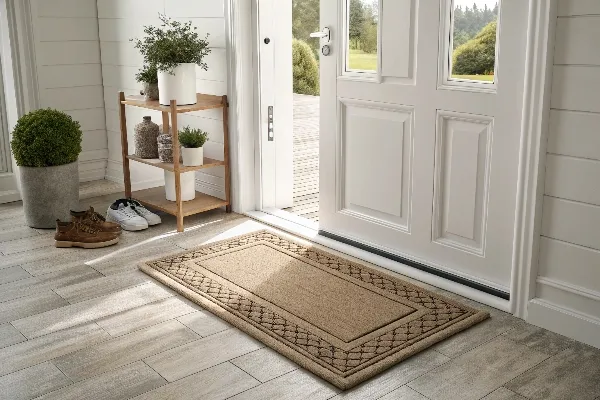
Benefits of an Outdoor Doormat
- First Line of Defense: Placing the mat outside is often the first line of defense against dirt, mud, and debris entering your home. It allows guests and family members to wipe their shoes before stepping inside, keeping your floors cleaner.
- Weather Protection: An outdoor mat2 is more exposed to the elements, but if made from the right materials (like coir or rubber), it can withstand rain, snow, and UV rays while keeping dirt at bay.
Benefits of an Indoor Doormat
- Cleaner Interior: An indoor doormat3 helps catch any remaining dirt that might have made its way inside. This is particularly useful for homes with pets or young children who might track dirt more frequently.
- Aesthetic Appeal: Indoor mats often add a layer of design and can contribute to the overall ambiance of your entryway. They come in a wider variety of patterns, colors, and textures, allowing you to express your style more.
- Longer Lifespan: Indoor mats typically last longer since they’re not exposed to harsh weather conditions, making them more durable over time.
Ultimately, whether you choose to place your mat inside or outside depends on your priorities—if you want the best dirt protection, go for an outdoor mat; if you prioritize interior style and a cleaner home, place the mat inside.
What is the best color for an outdoor mat?
Choosing the right color for your outdoor mat not only impacts the aesthetics of your home’s entrance but also affects its functionality. The color you choose can hide dirt, add a pop of color, or blend seamlessly with your home’s exterior.
The best color for an outdoor doormat should balance both practicality and style.
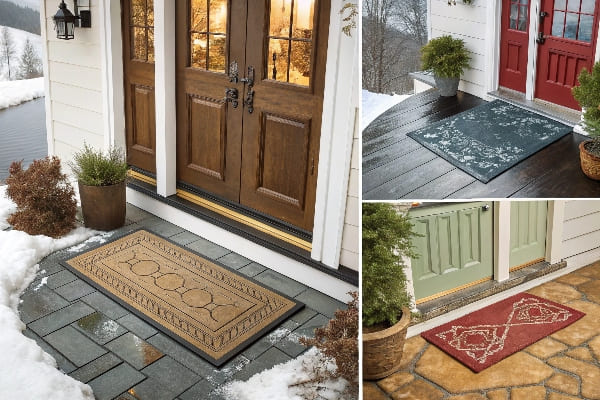
Practical Color Choices
- Dark Colors: Darker colors like black, navy, and brown are excellent choices for outdoor mats because they hide dirt, dust, and moisture stains better than lighter colors. They also provide a sleek, classic look.
- Earth Tones: Earthy tones like beige, taupe, and gray can complement a variety of home exteriors, from rustic to modern. They are also good at masking dirt without showing much wear and tear.
- Patterns & Designs4: Bold patterns or bright colors may be great for those looking to add personality to their front door. However, keep in mind that these colors might show dirt more easily, so they may require more frequent cleaning.
Color Considerations
When choosing a color, consider your home’s exterior and the climate in your area. If you live in a dust-prone area, dark colors might be more practical. On the other hand, a brightly colored mat can welcome guests with a cheerful vibe. Just be sure to select a color that can handle the weather conditions and still look fresh after many cleanings.
Conclusion
Doormats have come a long way, offering both function and style. Whether you need a mat that can handle heavy foot traffic, withstand bad weather, or complement your home’s exterior, there are plenty of options available. By choosing the right material, color, and placement, you can keep your home cleaner, more welcoming, and stylish.
-
Learn about the benefits of polypropylene doormats, including their water resistance and low maintenance needs. ↩
-
Explore the advantages of outdoor mats, including durability and dirt control, to enhance your home’s entryway. ↩
-
Learn how indoor doormats can keep your home cleaner and add aesthetic value to your entryway. ↩
-
Discover the impact of patterns and designs on outdoor mats, adding personality while considering maintenance needs. ↩

